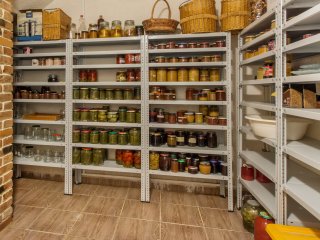
- Description
- Objectives
- Outline
- Materials
- System Requirements
With all the uncertainty in the world lately, you can find peace in being prepared. Have you been wanting to develop a food storage system for you and your family but do not know where to begin? Our Food Storage Basics course allows you to explore a variety of options and techniques for preserving, packaging, and storing food. We discuss how to create emergency food kits for short- and long-term use, how to safely store water, and methods for properly canning, drying, and freezing food. We also describe how to keep your food supply sustainable, fresh, and organized while maintaining balance and variety.
After completing this course, you should be able to:
- Identify how to properly package and store food for short-term and long-term emergencies
- Recall techniques for safely storing water and techniques for preserving food
- Recognize methods behind sustainable food storage and maintaining variety
- Describe how to organize and rotate through your food storage to maintain freshness
Food Storage Basics Module 1
Food Storage for Emergencies
The idea of having a supply of food on hand for emergency use is a wonderful idea because you never know when you will need it. Our first module describes the type of food that can be used for 72-hour kits, short-term kits (up to 3 months), and long-term kits, how to organize it, store it, and methods and items needed to cook it.
- Food for 72-Hour Emergency Kits
- Food for Short-Term Emergencies
- Food for Long-Term Emergencies
- Types of Food for Emergency Kits
- Cooking Items for Emergencies
Food Storage Basics Module 2
Storing Water and Preserving Food
It is recommended to store a gallon of water per person per day. There are many ways to safely store water for drinking, cooking, and washing. We discuss the pros and cons of each in this module. We also describe in detail how to can, dehydrate, freeze, and store various types of food to maintain adequate freshness.
- Storing Water
- Filling Your Containers and Rotation
- Preserving Your Own Food
- Canning and Dehydrating
- Packing Dry Foods for Long-Term Storage
Food Storage Basics Module 3
Sustainable Food Storage
Most of us can only grow and preserve a small portion of our food storage, so that means most will need to be purchased. In this module we discuss techniques for making large scale food purchases, such as selling other items or making lump sum payments. We also explore sustainable techniques like gardening and raising and keeping livestock.
- Buying Food
- Maintaining Balance
- Food Variety
- Sustainable Methods
Food Storage Basics Module 4
Organizing and Storing
As you build up your food storage, finding places for your food and keeping everything organized can present a challenge. In our final module, we explore unique food storage locations inside and outside of your home. We discuss organization methods and the importance of rotating through your stock.
- Storing Your Food
- Storage Locations
- Keeping Your Food Organized
- Using Your Food Storage
- Rotating Your Stock
Ed4Career is committed to being both environmentally conscious and making it easier for you to study! We’re making your education mobile! All of our textbooks are now provided as eTextbooks. You can access them on your laptop, tablet, or mobile device and can study anytime, anywhere.
The move away from physical books to eTextbooks means you get the latest, most up-to-date version available. This also makes your training more accessible, so you can study anywhere you have your phone or tablet. The best part is that all materials are included in your training cost so there are NO extra fees for books!
Internet Connection
- Broadband or High-Speed - DSL, Cable, and Wireless Connections
*Dial-Up internet connections will result in a diminished online experience. Classroom pages may load slowly and viewing large audio and video files may not be possible.
Hardware Requirements
- Processor - 2GHz Processor or Higher
- Memory - 1 GB RAM Minimum Recommended
PC Software Requirements
- Operating Systems - Windows 7 or higher
- Microsoft Office 2013 or higher. Also, you could use a general Word Processing application to save and open Microsoft Office formats (.doc, .docx, .xls, .xlsx, .ppt, .pptx)
- Internet Browsers - Google Chrome is highly recommended
- Cookies MUST be enabled
- Pop-ups MUST be allowed (Pop-up Blocker disabled)
- The Kindle Reader App or VitalSource Bookshelf App are needed for many of our courses (No special equipment needed. This can be downloaded for FREE onto your computer.)
- PowerPoint Viewer (if you do not have PowerPoint)
- Adobe PDF Reader
- QuickTime, Windows Media Player &/or Real Player
MAC Software Requirements
- Operating Systems - Mac OS x 10 or higher with Windows
- Mac office programs or a Word Processing application to save and open Microsoft Office formats (.doc, .docx, .xls, .xlsx, .ppt, .pptx)
- Internet Browsers- Google Chrome is highly recommended
- Cookies MUST be enabled
- Pop-ups MUST be allowed (Pop-up Blocker disabled)
- The Kindle Reader App or VitalSource Bookshelf App are needed for many of our courses (No special equipment needed. This can be downloaded for FREE onto your computer.)
- PowerPoint Viewer (if you do not have PowerPoint)
- Adobe PDF Reader
- Apple QuickTime Media Player
